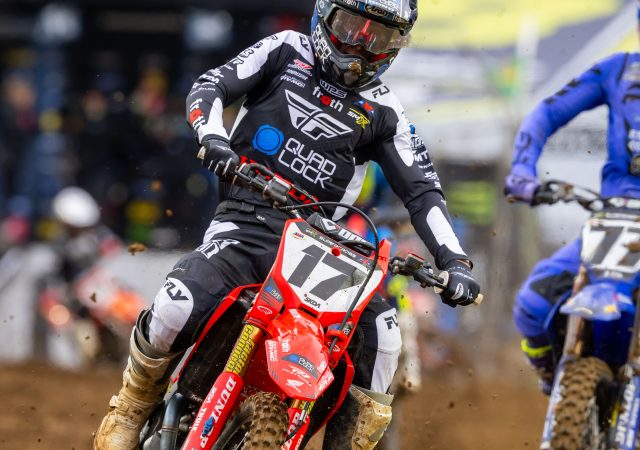For this edition of GP’s Classic Steel, we are going to take a look back at one of the most popular machines of the 1970’s, Honda’s groundbreaking XR75.
For this edition of GP’s Classic Steel, we are going to take a look back at one of the most popular machines of the 1970’s, Honda’s groundbreaking XR75.
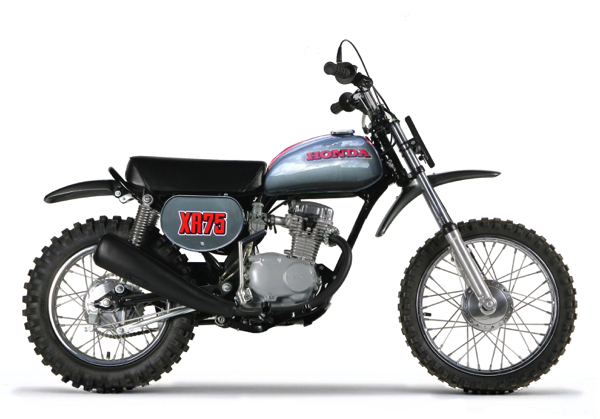 |
|
Perhaps no machine in history has introduced more young people to the joys of motorcycling than Honda’s little XR75. Starting in 1973 as a race bike, and later transitioned to a play machine, the XR and its decedents provided America’s youth (and often their parents) with four decades of uninterrupted fun. |
In the 1960’s, Honda was one of the most popular motorcycle brands in the world. They had made their name producing inexpensive and reliable commuter machines with names like Cub, Dream and Hawk. Unlike most brands of the time, Hondas didn’t leak, belch smoke or refuse to start at regular intervals. They generally went about their business in an unassuming manor and won over thousands of buyers not normally attracted to the rebellious and rambunctious lifestyle of sixties motorcycling. With bright, clean and well-lit showrooms, reasonable prices and tag lines like “You always meet the nicest people on a Honda,” they were the motorcycle for the common man.
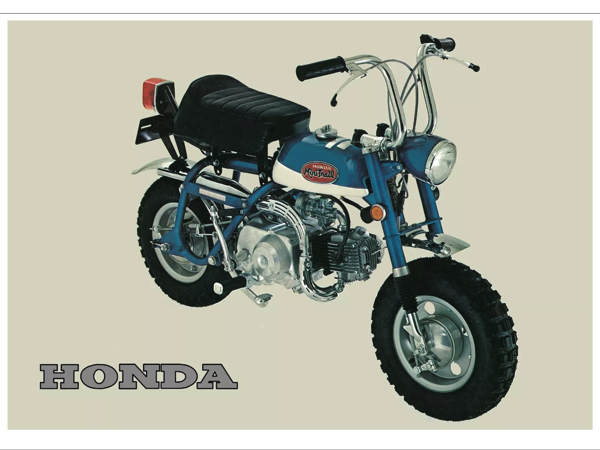 |
|
Prior to the introduction of the XR, Honda’s off-road machines basically fell into two categories, little trail runabouts like this Z50 Mini Trail, or high-piped street “Scramblers” like the CL450. Both sold in impressive numbers, but neither one was particularly adept at going fast once the pavement ended. |
While immensely popular in the street arena, Honda in the sixties had virtually no presence in the off-road market. They preferred to stick to road racing and let the other brands play in the dirt. In fact, it was not until 1968 that they finally introduced a machine for the off-road market – the Z50A Mini Trail. The Z50 was no race bike, but rather a simple and easy to manage trail bike with a three-speed auto-clutch transmission and a set of odd folding handlebars designed to make the bike easy to store in your car trunk. The new Mini Trail proved a massive hit and soon they were seen ripping around camp sites and backyards everywhere.
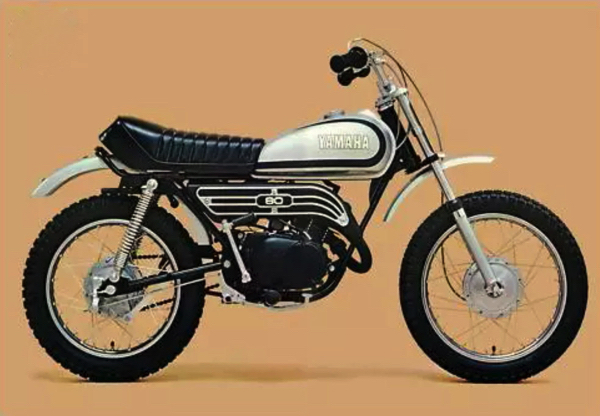 |
|
At the time of its introduction in 1973, the XR was the highest performance mini in the land. Amazingly, it out powered two-stroke competitors like Yamaha’s GT-MX80 and Suzuki TM-75 Mini Cross. Even the first YZ80 was unable to best it in tests of speed. By the middle part of the decade, however, the two-stroke minis had caught and passed the XR’s relativity meager performance. |
After the success of the Z50, Honda added a 72cc version for 1969 dubbed the CT70 or “Trail 70.” Like the Z50, the new Trail 70 was a small and easy to handle off-road machine with a mellow OHV four-stroke motor and automatic clutch. Also like the Mini Trail, the 70 featured the unique folding bars and compact dimensions that made it an ideal bike to cram in the trunk or hang off the back bumper. With the introduction of the Trail 70, Honda had another massive hit on their hands and buyers snapped them up in droves.
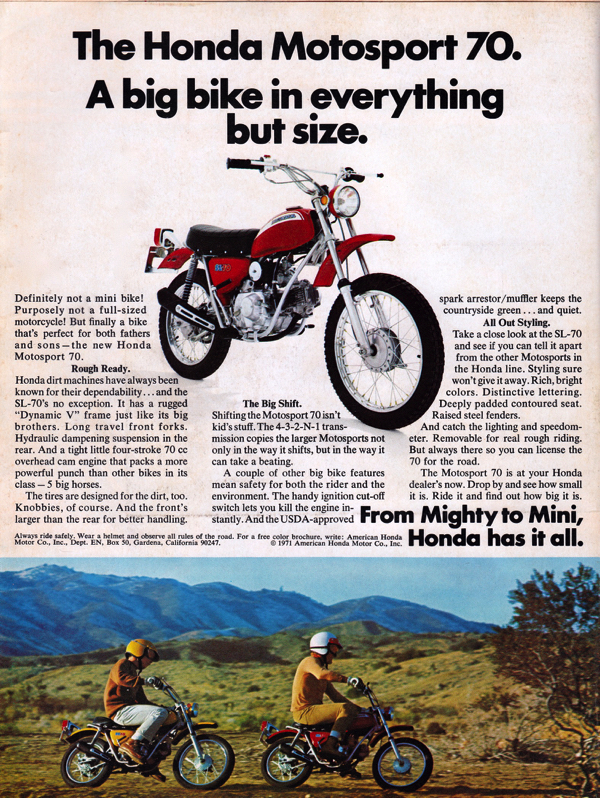 |
|
The Honda Motorsport SL-70 was a perfect example of the kind of off-road machines Honda was building prior to the XR75. Large enough to hold an adult, but too underpowered to be much fun, the SL was heavy, slow and more street bike than motocross racer. |
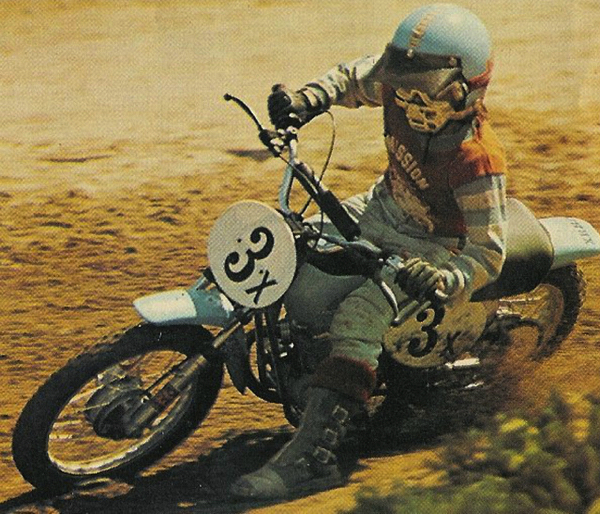 |
|
With the introduction of the new XR75 came an all-new phenomenon, the mini-class superstar. Hired by Honda to race the new thumper, Jeff Ward quickly put the XR on the map with his flawless style and blazing speed. |
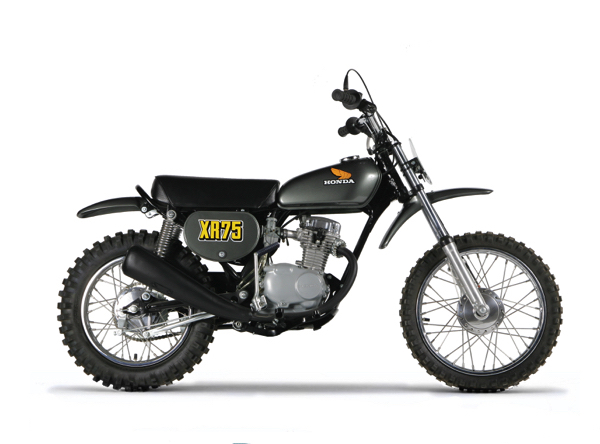 |
|
A new sleeker tank for 1974 slimmed the XR’s lines and made it look more like the new CR and less like the outgoing SL. |
In 1970, the SL70 Motosport joined the lineup and added the joys of a manual clutch to the off-road mix. The SL featured a more conventional frame than the Z50 and CT70, and offered a better platform for off-road fun. The motor remained in a very mild state of tune and offered a meager 6.5 horsepower to pull around its 153 pounds of bulk. It was less powerful and heavier than the two-stroke Yamaha Mini-Enduro, but offered better suspension and full street legal capability.
 |
|
In 1973, you really did meet the nicest people on a Honda. |
While Z50, CT70 and SL70 were all immensely popular; none of them were particularly good dirt bikes. They were easy to handle, reliable and fun, but less than appealing to the go-fast set. Some people tried to turn the SL70 into a race bike, with power-up kits and big-bore packages available from Webco and Poweroll, but these modifications sacrificed the bike’s anvil-like reliability for a few added ponies. The motor was never designed for the stresses of racing and many a hopped-up SL went BANG under the demands of race conditions.
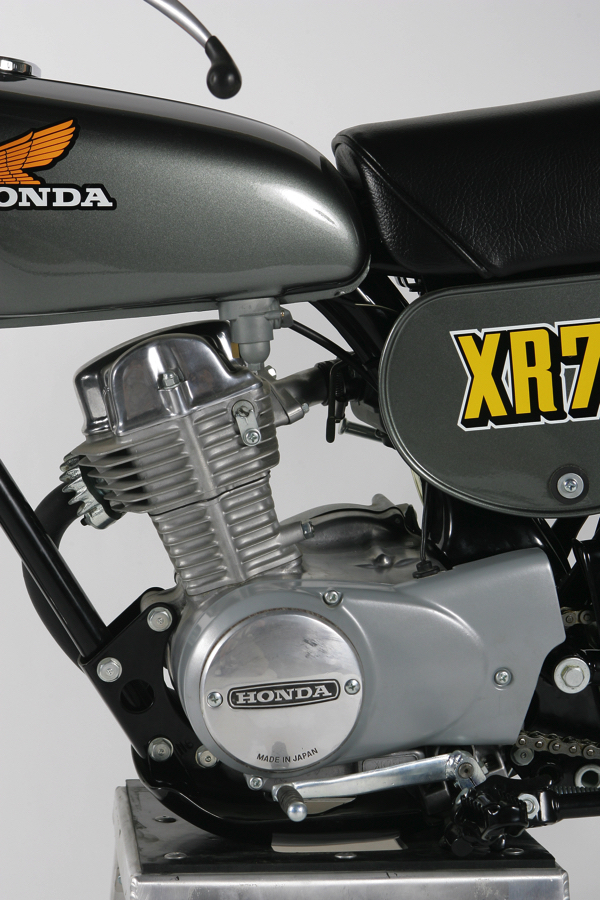 |
|
The 72cc mill on the XR shared most internal dimensions with the old CT and SL motors, but offered far more performance. The new upright cylinder and head featured bigger valves, more compression and a higher rev ceiling than the old laid-down mills. A larger carb and high-flow exhaust helped the new head breath and a close-ratio four-speed trans with straight-cut gears helped put the power to the ground. |
For those wanting a genuine off-road ready Honda, the wait was finally over in 1972, when Honda announced not one, but two off-road racers. The first was to be a full-on race bike, with a sturdy steel frame, full knobby tires, heavy-duty suspension and not a turn signal in sight. This bike would come ready to race with competition number plates, serrated steel pegs (no goofy rubber pegs here), plastic “unbreakable” fenders and a high performance motor. The bike would signal an all-new direction for Honda’s off-road program and fittingly, wear an all new designation – XR.
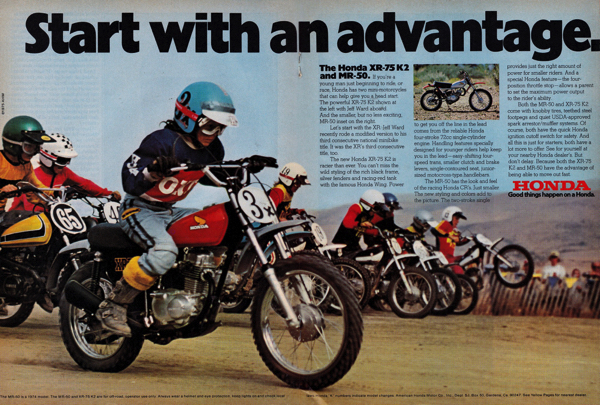 |
|
Jeff Ward and his Honda XR75 became a staple of motocross magazines in the mid-seventies. |
The all-new XR75 would make its debut in the fall of 1972, a full month before its scene-stealing big brother the Elsinore would make it to these shores. The XR was small, but incredibly trick for the time, with beautiful fit and finish and a purposeful look. Gone was the moped-style laid down motor of the CT and SL. In its place was an all-new mill that screamed performance. Tight, compact and no-nonsense, the 72cc mill shared the displacement of the SL motor, but little else. Sporting a 47 x 41.4mm bore and stroke and 8:8.1 compression ratio, the new mill featured larger valves, a higher rev ceiling and a bigger carb (19.5mm Keihin) than the old power plant. Complementing the new top end was a high-flow exhaust, less restrictive airbox and lightweight magneto ignition. Putting the power to the ground was a rugged manual clutch and close-ratio four-speed transmission with straight-cut gears for durability.
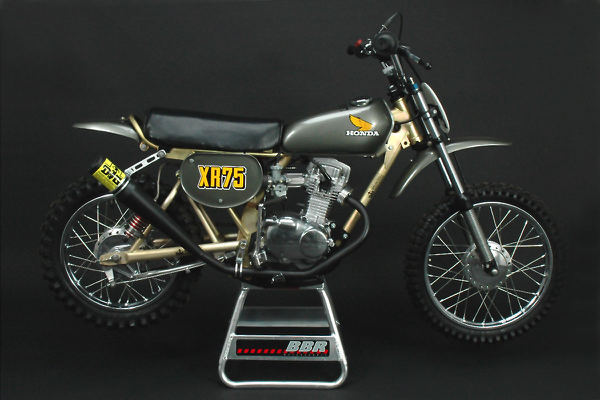 |
|
If you really wanted to get crazy with your pit bike racer, then you ponied up $349 (keep in mind the stock XR only cost $470 in ’74) for this ultra-trick DG monoshock frame complete with a gas-charged Bilstein shock. Add in aftermarket forks, head mods, a cam, a J.W.R.P ignition and a DG pipe, and you could start to see how the pit bike thing became a drain on many a college savings fund in the mid-seventies. Photo Credit: Duane Brown |
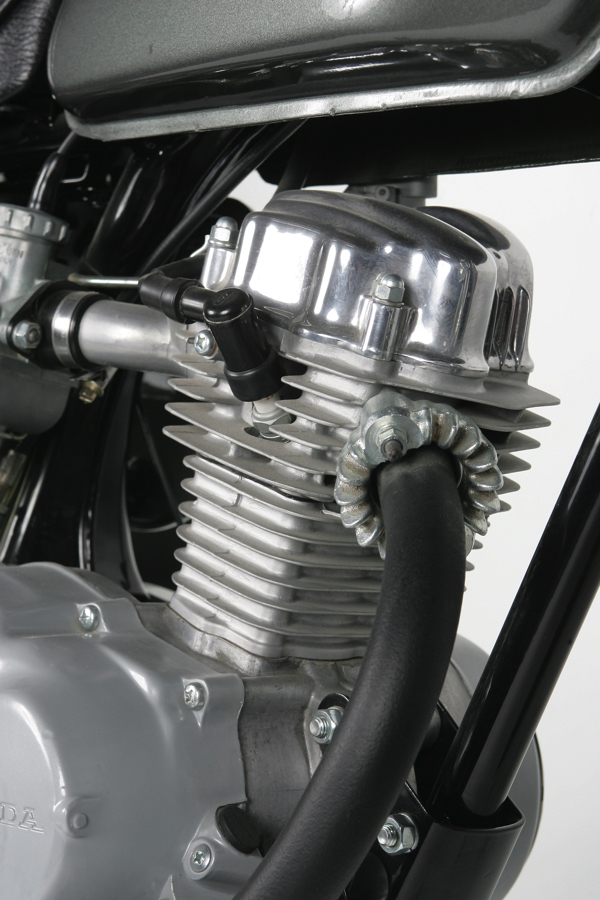 |
|
The little engine that could: While never an absolute rocket, the stock XR motor was strong, smooth and absolutely bulletproof (aside from the occasional oil leak). It had no problem pulling around adults in stock condition and got WAY faster with some careful massaging by knowledgeable tuners. With minor modifications, this basic engine design would power Honda mini bikes for over four decades. |
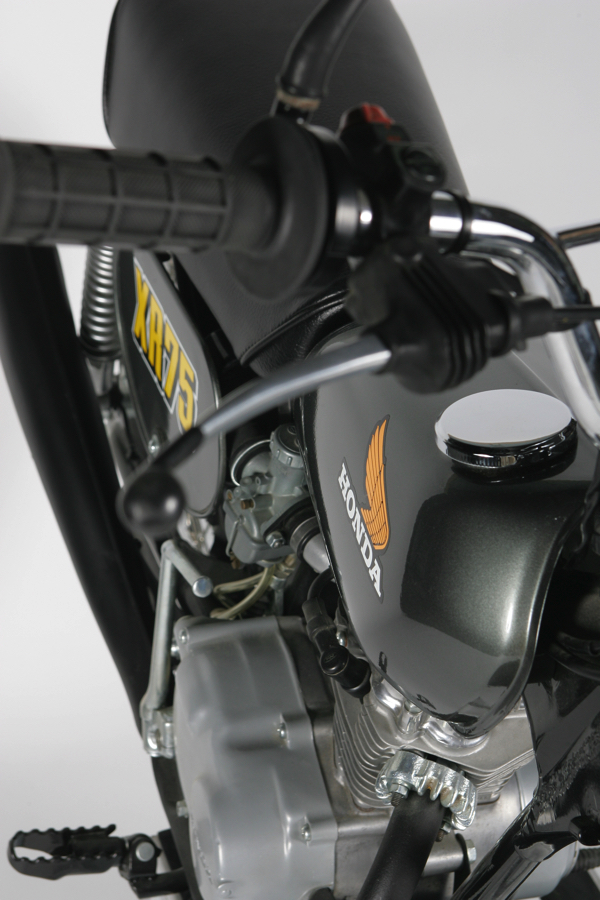 |
|
Trick features like the lever-enclosing dust covers and motocross-style serrated pegs showed Honda’s attention to detail on the new XR. |
While the new motor was no rocket, it was more than up to the challenge of keeping up with its competition. It was far more powerful than the outgoing SL mill and easily capable of toting full size adults around the track (a task that would have had the SL begging for mercy). It was smooth, torquey (by mini bike standards) and amazingly, actually faster than most of its mini-class rivals at the time. Yamaha’s new YZ80 held a slight advantage out of the hole, but the superior top-end power of the XR pulled it ahead every time. The smooth-shifting four-speed transmission and excellent clutch also helped keep the little four-banger in the meat of its power and made the best use of its broad powerband.
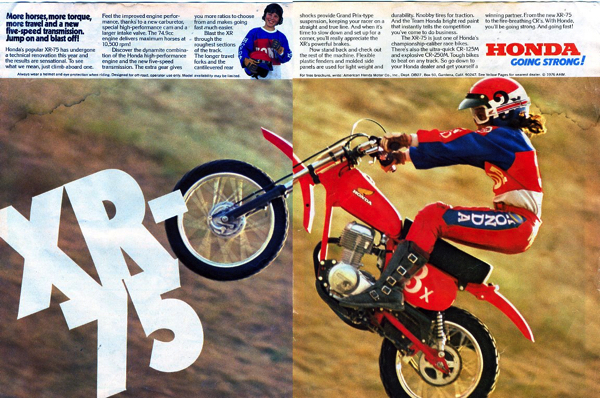 |
|
More displacement, a new carb, new cam and longer travel suspension were all on the XR docket for 1977. Even with these improvements, however, the XR was quickly falling behind the performance of its two-stroke rivals. By 1980, the CR80R would be on the scene, relegating the XR to play bike status for the remainder of its forty-year run. |
Aiding the XR’s race-readiness was an all-new frame and rugged off-road ready suspension. The new frame was stronger and lighter than the outgoing SL unit and featured a single downtube and beefy stamped steel backbone. The design used the engine as a stressed member and tied the front and rear sections together with a monocoque style center section. Under the motor was a full skid plate and a rather odd set of peg mounts that placed one peg farther forward of the other for some inscrutable reason.
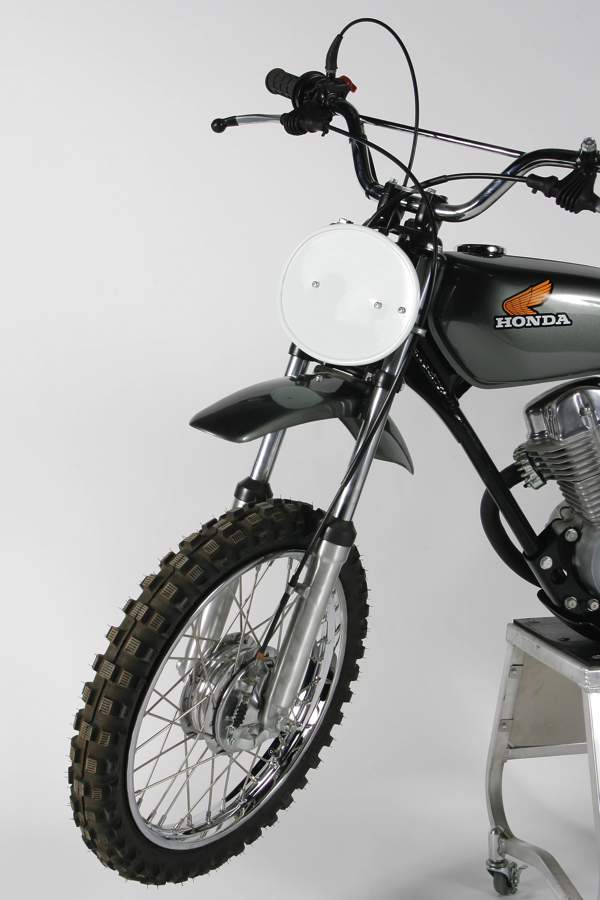 |
|
Quality silverware: While not incredibly plush, the XR’s stock forks were capable of handing anything a pint-sized mini pilot was capable of throwing at it in 1974. Set up on the stiff side, they were better at charging that puttering around the campsite. One magazine at the time even proclaimed them the best set of forks found on a production machine of any size in 1974. |
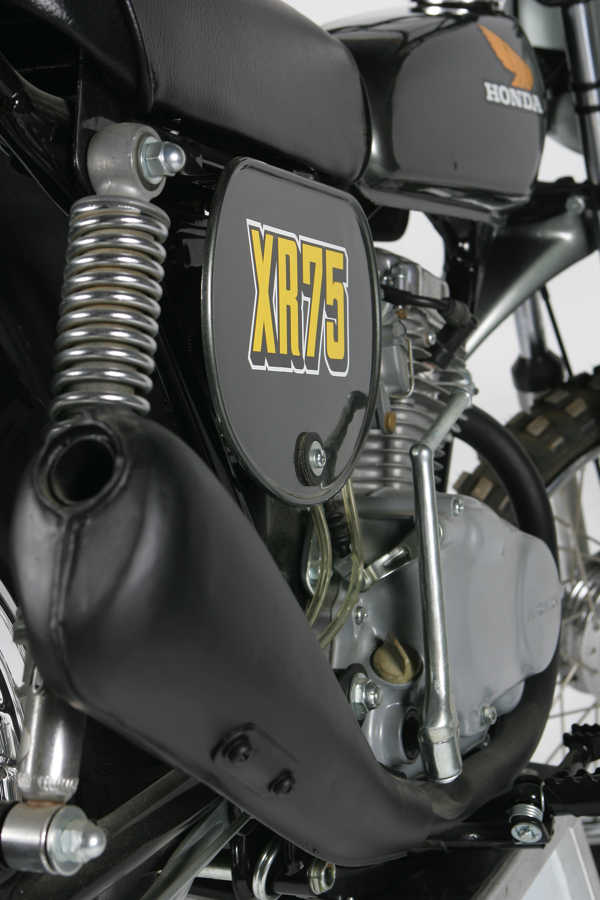 |
|
The stock exhaust on the XR was both efficient and incredibly quiet. At a mere 76 decibels, the stock bike could be ridden in the backyard without incurring the ire of Fred and Ethel next door. Of course once Dad got that sweet DG megaphone for his XR pit bike, all that went out the window. |
Handling was considered excellent at the time, with good turning and decent stability for a bike with such a short wheelbase. The little XR was easy to wheelie over obstacles with the proper amount of body English and slid well under power. Even with full-size adults on board, the bike felt solid and did not do anything weird or spooky. The only real weak point on the chassis turned out to be those curious pegs, which were mounted directly to the bottom of the engine cases. If ridden hard and not watched constantly, the mounts would become stripped out and fail. Other than that, Honda’s little mini bike was bulletproof.
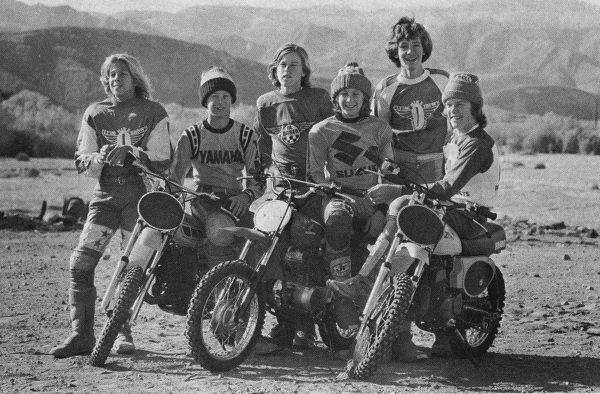 |
|
In 1977, Chris Heisser, A.J. Whiting, Johnny O’Mara, Steve Schmitz, Mike Brown and Jim Holley shot out the mini class of ‘77 for Dirt Bike magazine and found the XR fun, but underpowered compared to the RM80 and YZ80. It remained an excellent and easy-to-ride machine, but its days as a competitive racer were quickly fading into castor bean smoke. Photo credit: Dirt Bike |
In the suspension department, the XR used a set of non-adjustable telescopic front forks and dual rear shocks. The units themselves were similar to the components found on the SL70, but both ends offered slightly longer travel and stiffer damping. Performance was considered excellent at the time and Popular Cycling even proclaimed the forks to be the best damped units in the industry. While both ends were slightly stiff for light trail riding, they proved excellent on the track and capable of handling the punishment delivered by fast juniors or having Dad in the saddle.
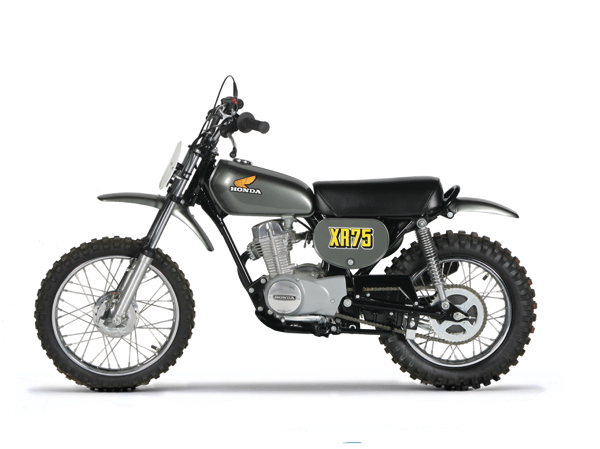 |
|
The Honda XR75 may not have been as glamorous as its Elsinore big brother, but it did every bit as much to put Honda on the off-road map in the 1970’s. It was a serious and no-nonsense off road machine that introduced countless thousands of kids to the joys of going off-road on a Honda. Part play bike, part racer, it was a machine so perfect in its mission and execution that it lasted for forty years as a staple of Honda’s lineup. It came first, and in the end, it actually outlasted both the bike that eventually replaced it and the bike that stole its thunder in ’73. |
In 1972, Honda fired two groundbreaking salvos across the bow of the off-road industry. The first shot, was the Honda XR75, soon to be followed by Honda’s first two-stroke, the amazing CR250M Elsinore. The XR75 was a whole new type of off-road Honda. Built for performance, it was light, compact and ready to race right out of the crate. There were no lights to strip off and no DOT froof that needed to be disconnected. It was a serious, purposeful and the catalyst for a mini off-road revolution. Within a year of the XR’s launch, there were frames, exhausts, big-bore kits and all manner of aftermarket go-fast goodies available to turn your XR from mild to wild. Eventually, the two-stroke mini’s caught and passed the venerable XR75, but its legacy continued with the XR80R, and later CRF80F. For four decades, it soldiered on as one of the most indestructible, enduring and beloved bikes in Honda’s lineup. Race bike, pit bike, or backyard plaything, the XR always remained true to its one defining mission – having fun.
For your daily dose of old-school moto goodness, make sure to follow me on Twitter and Instagram -@TonyBlazier
For questions or comments, feel free to drop me a line anytime at TheMotocrossVault@Gmail.com



